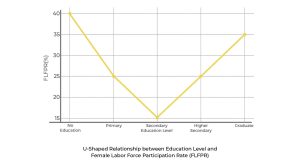No Women Left Behind: Why Female Workforce Participation in India Must Rise

“In addition to the external barriers erected by society, women are also hindered by barriers that exist within ourselves. We hold ourselves back in ways both big and small, by lacking self-confidence, by not raising our hands, and by pulling back when we should be leaning in. We internalise the negative messages we get throughout our lives – the messages that say it’s wrong to be outspoken, aggressive, more powerful than men. We lower our own expectations of what we can achieve”. – Lean In: Women, Work, and the Will to Lead – book by Nell Scovell and Sheryl Sandberg.
Women have made significant strides in education, entrepreneurship, and the workforce. Today, we see more women in boardrooms, leading startups, and entering male-dominated industries. Yet, progress remains uneven. Female workforce participation in India is still among the lowest in the world, and many drop out due to unpaid caregiving responsibilities, workplace biases, and lack of flexible work options. At the same time, internalised barriers persist. From a young age, many women are conditioned to prioritise family over career, to doubt their ambitions, and to hesitate before speaking up. These struggles are not just personal; they are systemic.
The latest report for 2024, published by the World Economic Forum (WEF), provides crucial insights into India’s standing in the Global Index. The report reveals that India has fallen two spots from the previous year, ranking 129th out of 146 countries surveyed. A significant concern highlighted in the report is the literacy rate among women. According to the 2011 census, only 63% of women in India are literate, a stark contrast to the male literacy rate, which is 80%. This disparity places India below the global literacy average of 83%, with the national literacy rate languishing at just 74%. The limited educational opportunities and lower contributions from women are critical factors contributing to this troubling situation, underscoring the urgent need for efforts to bridge this gender gap in education and literacy. Addressing these challenges is essential to improving female workforce participation in India and ensuring equal opportunities for all.
How education impacts female workforce participation in India
TeamLease’s recent report – No Women Left Behind – highlights the critical role education plays in women’s labor force participation (LFPR). The rise in educational attainment has played a pivotal role in shaping women’s participation in the labour force, creating a U-shaped trend in the female labour force participation rate (LFPR). Women with limited education often enter the workforce out of economic necessity, typically taking up roles in informal or low-wage sectors. Meanwhile, those with higher educational qualifications secure professional careers, leading to increased workforce participation at both ends of the spectrum. However, women with mid-level education (secondary level) experience a dip in LFPR before it rises again as they attain advanced qualifications. This pattern highlights the crucial role of higher education in equipping women for meaningful careers that offer financial stability and job satisfaction.
Is female workforce participation in India any better in the contractual sector?
From the contract workforce point of view, a significant portion of women contract workers hold a graduation degree (41.3%), followed by those who have completed 12th grade (28.5%). A smaller percentage have only a 10th-grade education (18.8%), while postgraduates (10.2%) and diploma & ITI holders (1.2%) make up a minor share. This indicates that a majority of female temporary workers possess at least a higher secondary or graduate-level education.
The regional distribution of women in the contractual workforce shows that Maharashtra (28.7%) leads significantly, followed by Tamil Nadu (14.2%) and Karnataka (14.1%). Other key states include Telangana (7.8%), Gujarat (7.2%), and Uttar Pradesh (6.6%). This suggests that metropolitan and industrial hubs remain dominant in providing contractual employment for women, pointing to the need for expanding opportunities in tier-2 and tier-3 cities to encourage broader workforce participation.
The biggest challenges holding women back
The report talks about the 19 key persistent challenges that hold women back. Here are the top 10:
- Socio-Cultural Barriers: Despite NEP 2020’s commitment to advancing women’s rights, deeply ingrained patriarchal traditions and gender biases continue to obstruct women’s access to education.
- Inadequate Awareness of NEP Provisions: A significant barrier arises from the limited awareness among communities, especially in rural areas, which remain unaware of the educational opportunities and reforms provided by NEP 2020, limiting their ability to fully benefit from these initiatives.
- Unpaid Work and its Economic Implications: Unpaid work, such as caregiving and household chores, is predominantly performed by women in India. Women in India spend an average of 5 hours per day on unpaid domestic and caregiving work, compared to 1.5 hours for men.
- Digital Divide: Many women lack access to essential devices and reliable internet connectivity, severely limiting their participation in online learning.
- Limited Vocational Training and Career Counseling for Women: Although NEP 2020 encourages vocational education, women often lack access to tailored career guidance and vocational programs, particularly in non-traditional fields.
- Work-Life Balance: A recent study by the Indian Institute of Management Ahmedabad (IIMA) revealed that 67% of women struggle with work-life imbalance, underscoring the significant challenges they face in managing professional responsibilities alongside personal commitments.
- Gender Pay Gap: The gender pay gap in India is a significant issue as it is 39.8%, meaning Indian women earn 39.8 rupees for every 100 rupees earned by men. Women frequently earn lower wages than men for similar work due to occupational segregation, discrimination, and biases in hiring and promotions.
- Safety and Security Concerns: Women face significant safety concerns while traveling to schools and colleges, particularly in rural areas. Parents often hesitate to send their daughters due to fears of harassment and violence, leading to discouragement from pursuing education altogether.
- Lack of Mentorship and Role Models: The absence of visible female leaders and mentors in academia and professional sectors reduces encouragement for young women to pursue higher education and careers in STEM.
- Policy and Regulatory Environment: While India has tried to promote gender diversity in workplaces, these policies often lack effective compliance and enforcement. The Companies Act of 2013 mandates disclosures about gender diversity on corporate boards, yet women hold only 21% of board seats in NSE-listed companies.
From challenges to change
Empowering women starts with a supportive environment that promotes equal treatment from a young age. The attitudes of spouses and in-laws also significantly affect women’s professional journeys. While addressing cultural challenges can be complex, support from policymakers, business leaders, and community figures can foster an environment where women thrive in leadership roles. A future where women are free to pursue their ambitions without barriers is not just possible—it is necessary. By fostering an environment that values equal opportunities, challenges biases, and supports women at every stage of life, we can build a more just and prosperous society. Strengthening female workforce participation in India is a crucial step toward achieving this vision.
If you’re looking to build a more inclusive workforce and put more women to work, reach out to us. Let’s work together to create workplaces where women don’t just participate but thrive.
Latest Blogs
New Labour Code: A Workforce Wake-Up Call for India
For years, India’s labour ecosystem resembled a dusty filing closet, layered, confusing and waiting for someone brave enough to open it. The arrival of the...
Read More4 New Labour Codes: How Workers and Employers Benefit
Reforms shape the future only when they simplify the present. India’s new Labour Codes stand out as one of the most meaningful updates to the...
Read MoreEmployer of Record (EOR) Services: Hire in India
According to the International Monetary Fund (IMF), India remains the only major economy projected to grow above 6% in FY 2025, with a forecasted GDP...
Read MoreRPO vs Contract Staffing: Choosing the Right Talent Model
The Talent Dilemma: Balancing Long-Term and Short-Term Hiring Needs Priya, the HR Head of a fast-scaling Indian startup, faced a familiar challenge. Her company was...
Read MoreWhat Are the 3 New EPFO Withdrawal Rules? Explained Clearly
Social security isn’t about saving for retirement; it’s about staying secure through every stage of work.” The Employees’ Provident Fund Organisation (EPFO) has revamped its...
Read More






